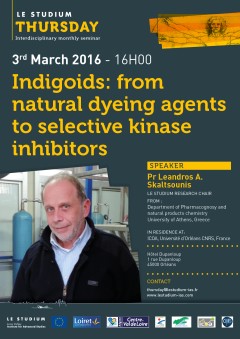Institute of Organic and Analytical Chemistry (ICOA)


Université d’Orléans - Pôle de Chimie
Rue de Chartres - BP 6759
Orléans 45067
France
The Laboratory's mission is to identify new bioactive molecules with potential applications in therapeutics and cosmetics. Research at the Institut de Chimie Organique et Analytique (ICOA) focuses on the design, synthesis and analysis of molecules with potential applications in the life sciences. Within the Institute, the design of new chemical entities is based on molecular modelling, organic synthesis (heterocycles, sugar and nucleoside analogues, enzymology) and the extraction of plants using separative techniques and mass spectrometry analysis. ICOA's structure has been strengthened by the Bioactive Molecules Laboratory, a joint laboratory between institutions and Laboratoires Servier. ICOA also has a partnership space dedicated to hosting start-ups, where 3 R&D companies are working.
ICOA is strongly integrated into the Centre-Val de Loire region, and participates in or coordinates numerous private partnerships in collaboration with regional competitiveness clusters. The laboratory is also a CEA Corresponding Research Laboratory (LRC M09) and a member of the FR 2708 Research Federation with the CBM (UPR 4301). Finally, the laboratory enjoys national and international recognition, thanks in particular to its high scientific productivity and its membership, since 2012, of two networked Laboratories of Excellence (LABEX), SynOrg and IRON.
Research themes
Structural bioinformatics and chemoinformatics (sb&c):
Development of molecular modelling and chemoinformatics methods such as virtual screening, machine learning, chemical library design and molecular dynamics. Applications in drug design and cosmetics in collaboration with chemists and biologists.
Glycobio&chemistry:
Glycomolecules, from synthesis to enzymology: Glycochemistry: New synthesis methodologies. Synthesis of glycosaminoglycans, glycomimetics (iminosugars, thiosugars). Monomers, oligomers and polymers, bio-based surfactants. Chemo-enzymatic synthesis. Structure and mechanism of glycosyltransferases and glycosidases, molecular engineering. Synthesis of inhibitors as probes and potential therapeutic agents (lysosomal diseases, leishmaniasis, tuberculosis).
Heterocycles, nucleosides and imaging agents (hnai):
Methodologies for the synthesis of heterocycles, rare heteroaromatics, nucleos(t)id analogues. Asymmetric synthesis, metallo-catalysed couplings, C-H activation, macrocyclisation, spirocyclisation. Microwave, sonochemistry, continuous flow chemistry. Therapeutic molecules and chemobiology. Imaging probes and sensitisers (fluorescence, 18F PET, MRI/optical, etc.) in vitro and in vivo. Prodrugs, controlled release, molecularly imprinted polymers (MIP-DDS), bioanalysis.
Methodologies, heterocyclic chemistry, green chemistry (mchcv):
N,O,S-Original aromatic and non-aromatic heterocycles, Catalysis (Pd, Cu, Fe, Rh, Zn ...); Organometallic chemistry; Asymmetric and stereoselective synthesis; Synthesis under microwave irradiation or by photochemistry; Multi-step synthesis; Hemisynthesis and biosynthesis; Glycomimetics for therapeutic purposes, non-natural amino acids.
Analytical strategies, affinities and bioactives (saab): Extraction, structural characterisation and assay of natural or synthetic molecules in complex mixtures (plants, pharmaceutical and cosmetic products, biological matrices, cell extracts); Statistical and chemometric data processing; Coupling extraction techniques/separative techniques (SFE/SFC, DHS-SBSE/GC) and separative techniques/mass spectrometry (UHPLC, HPTLC, CE, SFC, GC, CPC); Microfluidics and microemulsions (MIP); Innovative methods for the rapid screening of enzyme inhibitors; Study of achiral and chiral recognition mechanisms for the reasoned development of separative techniques.
Experimental resources:
- 400 MHz and 250 MHz NMR, Q-Tof MaXis HRMS, ESI, APCI, APPI sources, nano-ESI, Maldi-Tof, thermophoresis, 3 triple quad mass spectrometers, ESI, APCI, APPI sources.
- Separative methods HPLC, nano-LC, UPLC, SFC, GC, CE, HPTLC, CPC, Light Scattering Detectors (LSD)
- Dell PowerEdge R710 and Xeon Gold CPU cluster and NVIDIA TESLA K20, K80, GTX TitanZ, and RTX2080 and 3090 GPU cards
- Glass-blowing workshop


















